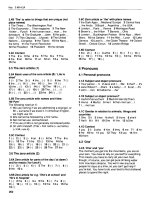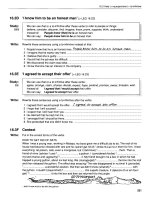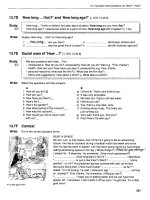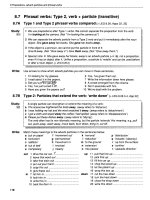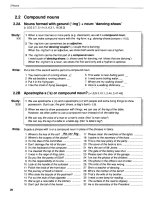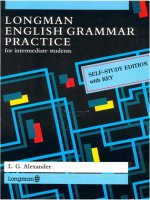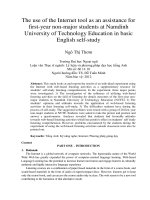pace-university-approved-self-study-design
Bạn đang xem bản rút gọn của tài liệu. Xem và tải ngay bản đầy đủ của tài liệu tại đây (563.5 KB, 28 trang )
Profile of Pace University
Pace University educates a diverse student body that is welcomed and included in the benefits of higher education
by Pace’s history and mission of Opportunitas:
Our mission is Opportunitas. Pace University provides to its undergraduates a powerful combination of
knowledge in the professions, real-world experience, and a rigorous liberal arts curriculum, giving them
the skills and habits of mind to realize their full potential. We impart to our graduate students a deep
knowledge of their discipline and connection to its community. This unique approach has been firmly
rooted since our founding and is essential to preparing our graduates to be innovative thinkers who will
make positive contributions to the world of the future.
At the heart of Pace’s academic values is a historic commitment to excellence in teaching, as manifested by small
classes, an emphasis on skill development and critical thinking, special tutoring and support services, and
academic advising. Academic experiences at Pace emphasize teaching from both a practical and theoretical
perspective, drawing on the expertise of faculty members who balance academic preparation with professional
experience to bring a unique dynamic to the classroom. Pace has grown from its humble beginnings as a small
accounting institute in 1906 to a robust liberal arts university offering 108 undergraduate majors, 51 master’s
degrees, six doctoral degrees, seven law programs, 20 self-contained certificate programs, and many other
certificate programs within existing degree programs. At the core of a Pace education is a strong foundation in
arts and sciences that enriches students intellectually and personally, preparing them to become lifelong learners.
New degree programs and academic tracks continue to meet the 21st century’s marketplace demands, while
producing Pace graduates capable of inventing new futures for not only themselves, but for their communities and
the world.
The University’s educational mission is carried out by 490 full-time and 783 part-time faculty members (2016).
Over 89 percent (89.8%) of these full-time faculty members have doctoral degrees or terminal degrees appropriate
to their disciplines. The University employs 1,095 full-time and 817 part-time staff to support the academic and
administrative needs of the institution.
Pace faculty includes some of the brightest minds in academia as well as professionals who have risen to the top
of their chosen fields. Their commitment to intellectual discourse and research is surpassed only by their desire to
help students realize their dreams. For the last few years, the University has hired approximately 20–35 new fulltime faculty each year who have helped evolve the University’s curriculum. This combination of Pace
University’s experienced faculty and new professors represents a powerful wave of intellectual growth to Pace’s
rising academic reputation.
The Pace mission serves its students well with post-graduation placement rates for undergraduate and graduate
students at 82% and 94% respectively. In addition, 11% pursue further education in graduate school on a full or
part-time basis. Students achieve these results through an emphasis on experiential learning that augments their
academic work. The Pace Path helps each student develop strengths in managing oneself, interpersonal relations,
and organizational awareness through curricular, co-curricular, and extra-curricular activities.
Pace delivers its mission on three degree-granting campuses: one in New York City (NYC) and two in
Westchester County: Pleasantville (PLV) and White Plains. Pace’s educational programs are executed through
four schools and two colleges with approximately 13,000 graduate and undergraduate students in fall 2016:
The Charles H. Dyson College of Arts and Sciences (Dyson) enrolls 4,577 undergraduate and graduate
students with 3,318 in New York City and 1,259 in Westchester. The Doctor of Psychology in School –
Clinical Child Psychology Degree (Psy.D.) is accredited by the American Psychological Association and
the Bachelor’s Degree Program in Chemistry is certified by the American Chemical Society.
The Joseph R. Lubin School of Business (Lubin) enrolls 4,172 undergraduate and graduate students with
3,332 in New York City and 840 in Westchester. Lubin is accredited for business and accounting by the
Association to Advance Collegiate Schools of Business (AACSB).
Pace University Self-Study Design
Page 1 of 28
The Ivan G. Seidenberg School of Computer Science and Information Systems (Seidenberg) enrolls 1,252
undergraduate and graduate students with 714 in New York City and 538 in Westchester. The BS in
Computer Science is accredited by the Computing Accreditation Commission of ABET, Inc.
The College of Health Professions (CHP) enrolls 1,206 undergraduate and graduate students with 622 in
New York City and 584 in Westchester. The baccalaureate degree in nursing, master’s degree in nursing,
and Doctor of Nursing Practice at Pace University are accredited by the Commission on Collegiate
Nursing Education (CCNE). The Physician Assistant Program is accredited by the Accreditation Review
Commission on Education for the Physician Assistant (ARC-PA).
The School of Education (SOE) enrolls 708 undergraduate and graduate students with 450 in New York
City and 258 in Westchester. The School of Education is accredited by the National Council for
Accreditation of Teacher Education (NCATE).
The Elisabeth Haub School of Law (Law) enrolls 563 students in Westchester. The School of Law is
accredited by the American Bar Association through its Council of the Section of Legal Education and
Admissions to the Bar Association, and is a member of the American Association of Law Schools.
An additional 365 students attend the University as non-matriculated students pursuing individual educational
goals.
Pace prides itself on serving a diverse and dynamic body of students:
Since 2007, Pace has thrived under the leadership of President Stephen J. Friedman. In 2015, President Freidman
announced that he would retire when his term ended on July 31, 2017. A search committee consisting of faculty,
students and staff, and led by the Board of Trustees selected Marvin Krislov as Pace’s eighth President. President
Krislov assumed his role on August 1, 2017.
Pace University Self-Study Design
Page 2 of 28
Intended Outcomes of the Self-Study
This Self-Study provides Pace with an opportunity to critically examine the University’s performance and
progress. Using a framework of the seven accreditation standards and the four themes of the Pace University
Strategic Plan, 2015-2020, the anticipated outcomes of the 2018-2019 Self-Study are to:
1. Achieve reaccreditation from the Middle States Commission on Higher Education.
2. Assess the effectiveness of experiential learning opportunities across the institution to evaluate how
learning from those experiences contributes meaningfully to student education.
3. Evaluate how assessment of student learning and related institutional improvement actions contribute to
student and alumni outcomes.
4. Outline the processes by which Pace’s institutional decision-making, including planning and resource
allocation, are aligned and enable Pace to meet its mission in the current and future higher education
environments.
5. Analyze whether the research and teaching requirements of Pace faculty are well supported by the
university’s administration and staff, and whether the university meets the needs of all its constituencies
and provides adequate resources for continuous improvement.
6. Identify opportunities to improve the effectiveness and efficacy of University policies, processes, and
procedures in support of Pace’s mission.
Pace University Self-Study Design
Page 3 of 28
Self-Study Structure
The Pace University Self-Study is led by an Executive Committee of four which provides overall leadership and
direction to the process. The Executive Committee is the primary liaison to the President, Provost, and Board of
Trustees. A Steering Committee consisting of the Chairs of each Working Group and other administrators and
support staff ensures that the Working Groups’ efforts are coordinated, and a cohesive report emerges from the
process. Each Working Group has a member of the Executive Committee as its liaison to assist with leadership
and direction.
The Working Groups were formed through an open nomination process. Faculty members were nominated by
their respective location or school-based faculty councils.
Executive and Steering Committee Membership
Executive Committee
Lisa Bardill Moscaritolo, Ph.D.
Associate Vice President and Dean for Students, PLV
Jean Gallagher
Vice President for Strategic Initiatives
Iuliana Ismailescu, Ph.D.
Associate Professor, Lubin School of Business
Hillary Knepper, Ph.D.
Associate Professor, Chair, Department of Public Administration, Dyson
College of Arts and Sciences
Steering Committee
Lisa Bardill Moscaritolo, Ph.D.
Associate VP and Dean for Students, Pleasantville
Rachel Carpenter
Assistant Dean, Assessment and Planning/Director, Student Development
and Campus Activities, Pleasantville (Standard I)
Cara Cea
Director, University Relations, Westchester (Standard II)
Jim Curry
Assistant Vice President, Office of Student Assistance (Standard IV)
Nancy DeRiggi
Assistant Vice President, Planning, Assessment and Institutional Research
Angelica Ferreira
Associate Vice President, Office of Budget and Planning (Standard VI)
Jean Gallagher
Vice President for Strategic Initiatives
Edward Goralski
Assessment Coordinator
Nira Herrmann, Ph.D.
Interim Provost and Executive Vice President for Academic Affairs
Iuliana Ismailescu, Ph.D.
Associate Professor, Lubin School of Business
Hillary Knepper, Ph.D.
Associate Professor, Dyson College of Arts and Sciences
Mariajose Romero, Ph.D.
Director of Assessment and Planning, Dyson College Arts and Sciences
(Standard V)
Fiana Sandy
Staff Associate, OPAIR
Christine Shakespeare
Assistant Vice President, Continuing Professor Education (Compliance)
Jim Stenerson, Ph.D.
Executive Director, Faculty Center for Professional Development
Daniel Strahs, Ph.D.
Associate Professor, Dyson College of Arts and Sciences (Standard VII)
Andrew Wier, Ph.D.
Associate Professor, Dyson College of Arts and Sciences (Standard III)
Pace University Self-Study Design
Page 4 of 28
Pace University Self-Study Design
Page 5 of 28
Charge to the Working Groups
The Working Group membership was finalized in spring 2017 and the groups began meeting with their Executive
Committee liaison in April 2017. Each working group was given a copy of the MSCHE Standards, the University
Strategic Plan, an Overview of the Accreditation process and the following charge.
Fully understand the Standard, its associated criteria, and the related Requirements of Affiliation.
Review and understand the research questions and how they are aligned with the Pace University 2015-20
Strategic Plan (Refer to Mapping attached).
Develop a work plan and research methodology for addressing the criteria and the research questions.
Develop milestones and establish an understanding of how the Working Group’s work aligns with other
Working Groups and with the final report
Research and evaluate Pace against the criteria with an objective assessment of the University’s
processes. Take a clear-eyed view of what is done well and where there are opportunities to improve.
Develop thoughtful recommendations that will result in meaningful institutional improvement.
This charge is reflected in the design summaries and data repositories included below.
Pace University Self-Study Design
Page 6 of 28
Standard I: Mission and Goals
The institution’s mission defines its purpose within the context of higher education, the students it serves, and
what it intends to accomplish. The institution’s stated goals are clearly linked to its mission and specify how the
institution fulfills its mission.
Working Group I Membership
Executive Committee Liaison: Lisa Bardill Moscaritolo, Associate Vice President for Student Affairs/Dean for
Students, Pleasantville
Chair: Rachel Carpenter, Assistant Dean for Assessment and Planning for Student Affairs, PLV
Membership:
Linda Jo Calloway, Ph.D., Professor of Information Technology, Seidenberg School of CSIS, NYC
Luke Cantarella, MFA, Associate Professor of Design, Dyson College of Arts and Sciences, NYC
William Colona, Director, Government and Community Relations
Sumeet Sunil Gujaran, Graduate Student Representative, Lubin School of Business, NYC
Working Group I Charge
Understand the mission, vision and strategic goals of Pace University.
Examine how the mission, vision and strategic goals guide University planning, decision-making and are
made manifest in the everyday life of the institution.
Examine areas of success and areas for improvement in University’s drive to fulfill its mission, vision and
strategic goals.
Address Requirements of Affiliation Seven and Ten.
Questions Specific to Standard I
1. In which ways does Pace provide a diverse student body with services and opportunities that support
students' academic, personal, and professional growth in alignment with the idea of Opportunitas?
2. How does Pace engage external entities in helping to adapt course offerings, curriculum development, and
new degree programs to current needs?
3. How does Pace leverage its locations and investments in institutional assets to advance its mission and
vision?
4. Does Pace demonstrate sufficiently broad participation, both internal and external, in the development,
promotion, and execution of departmental and college/school goals?
5. How does Pace’s recruitment and retention of faculty, staff, and administrators support the mission?
Approach
Review of key documents, processes, and initiatives that are driven by, or connected to, the institution's mission
and goals. This approach includes document review and analysis of the collected data. Any gaps in information
from documents will be gathered by conducting interviews with those connected to mission and goal driven
processes and initiatives
Pace University Self-Study Design
Page 7 of 28
Collaboration
Working Group I will collaborate with the following Working Groups:
III: Alignment of institutional learning outcomes/core curriculum objectives with the mission of liberal
arts curriculum.
IV: Assessment of the student experience in support of the mission.
V: Assessment of student learning aligned in support of the mission.
VI: Connections between planning processes and resource allocation and mission/goal.
VII: Evaluate connections between decision-making and governance structures to the strategic plan and
mission.
Pace University Self-Study Design
Page 8 of 28
Standard II: Ethics and Integrity
Ethics and integrity are central, indispensable, and defining hallmarks of effective higher education institutions. In
all activities, whether internal or external, an institution must be faithful to its mission, honor its contracts and
commitments, adhere to its policies, and represent itself truthfully.
Working Group II Membership
Executive Committee Liaison: Lisa Bardill Moscaritolo, Associate Vice President and Dean for Students,
Pleasantville
Chair: Cara Cea, Director, Media Relations
Membership:
Roberta Cable, Ph.D., Professor, Accounting, Lubin School of Business, PLV
Andriy Danylenko, Ph.D., Professor of Modern Languages and Cultures, Dyson College of Arts and Sciences,
NYC
Alan Eisner, Ph.D., Professor and Department Chair, Department of Management and Management Science,
Lubin School of Business; NYC
Debbie Levesque, Assistant Dean for Community Standards and Compliance
Kim Porter, Director of Operations, Outcomes & Assessment, Career Services
Working Group II Charge
Collects and analyzes information related to Standard II: Ethics and Integrity to ensure that the institution is
faithful to its mission, honors its contracts and commitments, adheres to policies, and represents itself truthfully.
Questions Specific to Standard II
1. In what ways does the University’s representation of the Pace Path and other experiential learning
opportunities reflect actual student experiences?
2. Are processes, practices, and policies that support students applied equitably to students enabling them to
obtain their degrees and achieve post-graduation goals?
3. How do Pace policies ensure equitable treatment?
4. How effective are Pace decision-making structures in valuing academic freedom?
5. How do Pace policies and procedures foster respect and guarantee a safe and inclusive environment in
which all students, faculty, and staff feel respected and valued?
Approach
Identify university documents that address the criteria and research questions.
Evaluate how these policies and processes are disseminated, conduct interviews to examine understanding
and knowledge of the policies and processes.
Complete an analysis of the effectiveness of the programs, policies and processes in terms of how well
they serve the University and meet the criteria.
Pace University Self-Study Design
Page 9 of 28
Collaboration
While reviewing the criteria for this standard it will be necessary to work with Working Group VII and
Compliance.
Pace University Self-Study Design
Page 10 of 28
Standard III: Design and Delivery of the Student Learning Experience
An institution provides students with learning experiences that are characterized by rigor and coherence of all
program, certificate, and degree levels, regardless of instructional modality. All learning experiences, regardless of
modality, program pace/schedule, level, and setting are consistent with higher education expectations.
Working Group III Membership
Executive Committee Liaison: Iuliana Ismailescu, Ph.D., Associate Professor of Finance, Lubin School of
Business, NYC
Chair: Andrew Wier, Ph.D., Associate Professor and Chair, Department of Biology and Health Sciences, Dyson
College of Arts and Sciences, PLV
Membership:
Demosthenes Athanasopoulos, Ph.D., Professor and Chair, Department of Biochemistry and Molecular
Biology, Dyson College of Arts and Sciences, NYC
Alexis Cusumano, Student, English Language and Literature, Dyson College of Arts and Sciences, NYC
Susan Feather-Gannon, Ph.D., Professor of Information Technology, Seidenberg School of CSIS, PLV
Beth E. Gordon, Ph.D., Assistant Vice President, Academic and Administrative Services
Shannon Marie Haick, Associate Director, Advising Center for Exploring Majors, Center for Academic
Excellence, NYC
Thomas McDonnell, J.D., Professor, Elisabeth Haub School of Law, White Plains
Working Group III Charge
Examine whether Pace provides its students the knowledge of their discipline, real-world experience, a
rigorous liberal arts curriculum (to its undergraduate students), and connection to their professional
community, as stated in the University mission.
Address Requirements of Affiliation Eight, Nine, Ten, and Fifteen.
Questions Specific to Standard III
1. In what ways does the core curriculum contribute to students' progress toward their academic, personal
and professional goals?
2. How does Pace ensure an appropriate level of academic rigor regardless of instructor status or course
modality?
3. To what extent do academic programs:
a. contain integrated experiential learning experiences?
b. foster development of discipline specific technology and skills?
c. integrate faculty research, teaching practices and networks to impact the student learning
experience?
4. How well does the University’s environment (physical and technological) support student outcomes?
5. How integrated are part-time faculty, administrators, and staff in the student learning experience?
Pace University Self-Study Design
Page 11 of 28
Approach
Review academic program requirements, course objectives and learning outcomes
Conduct a student survey of personal and professional goals
Review Pace program based assessments as well as Professional accreditation standards
Survey of Chairs and program administrators of specific technology and dedicated spaces
Review faculty-student publications, posters and presentations. e.g. Dyson Dean’s Annual Scholarship
reports, student research programs, and internships
Collaboration
Working Group III will work closely with Working Groups I, IV, V, and VII.
Pace University Self-Study Design
Page 12 of 28
Standard IV: Support of the Student Experience
Across all educational experiences, settings, levels, and instructional modalities, the institution recruits and admits
students whose interests, abilities, experiences, and goals are congruent with its mission and educational
offerings. The institution commits to student retention, persistence, completion, and success through a coherent
and effective support system sustained by qualified professionals, which enhances the quality of the learning
environment, contributes to the educational experience, and fosters student success.
Working Group IV Membership
Executive Committee Liaison: Iuliana Ismailescu, Ph.D., Associate Professor of Finance, Lubin School of
Business, NYC
Chair: James J. Curry, Jr., Assistant Vice President, Office of Student Assistance, Enrollment Management
Membership:
Vincent F. Birkenmeyer, MPA, Associate Chair, Assistant Director Residential Life, Student Affairs, PLV
Precious Hose, Student, Dyson College of Arts and Sciences, PLV
Barry Morris, Ph.D., Associate Professor of Communication Studies, Dyson College of Arts and Sciences, NYC
Michael Rosenfeld, MPhil, Director, Center for Academic Excellence, NYC
Kathy Winsted, Ph.D., Associate Professor of Marketing, Director, Center for Student Enterprise, Lubin School
of Business, PLV
Working Group IV Charge
Working Group IV will assess the student experience from acceptance to alumni status, in terms of how well the
University
supports those that it admits with a rich and diverse learning and living environment that fosters
opportunities for transformational growth,
works to ethically and effectively promote their persistence to graduation,
cultivates qualities essential to life-long personal and academic growth
upholds its commitment to our motto of Opportunitas and providing upward mobility for those who enroll
Working Group IV will address Requirements of Affiliation Eight and Ten.
Questions Specific to Standard IV
1. Does Pace routinely and innovatively support all students’ experiential learning in policies, practices and
resources?
2. How effective is Pace at identifying students who are not adequately prepared for study at the level for
which they have been admitted, and supporting them in attaining appropriate educational goals?
3. To what extent do Pace’s existing policies, procedures and practices support student success, retention
and degree completion?
4. What processes does Pace use to identify and evaluate the most important performance factors in
increasing retention, graduation, transfer, and placement rates? How do those processes result in the
effective allocation of resources for student success?
5. How often does Pace assess the effectiveness of programs (including staff, space and financial resources)
supporting the student experience, and how quickly are necessary changes implemented?
Pace University Self-Study Design
Page 13 of 28
6. What collective efforts does the University make (faculty, administrators and staff) to create a positive
experience for our students and keep them socially engaged with Pace post-graduation?
Approach
Data review of existing surveys and reports (NSSE and BSSE, data that has been collected from various
support programs)
Interviews of program directors, administrators, faculty that lead support programs
Possible primary research through interviews/surveys/ focus groups of students
Collaboration
Working Group IV will work with Working Groups I, III, V, and VI to review data points and collaborate on
information shared.
Pace University Self-Study Design
Page 14 of 28
Standard V: Educational Effectiveness Assessment
Assessment of student learning and achievement demonstrates that the institution's students have accomplished
educational goals consistent with their program of study, degree level, the institution's mission, and appropriate
expectations for institutions of higher education.
Working Group V Membership
Executive Committee Liaison: Jean Gallagher, Vice President for Strategic Initiatives
Chair: Mariajosé Romero, Ph.D., Director of Assessment and Planning, Dyson College of Arts and Sciences
Membership
Burcin Col, Ph.D., Assistant Professor, Lubin School of Business, NYC
Brian Evans, Ed.D., Assistant Provost for Experiential Learning, Coordinator of Pace Path, and Professor,
School of Education, NYC
Martha Greenberg, Ph.D., Professor College of Health Professions
Jennipher Lombardo, Director of Assessment and Planning, College of Health Professions
Laurie McMillan, Ph.D., Associate Professor, Dyson College of Arts and Sciences, PLV
Working Group V Charge
Collect and analyze information related to Standard V: Educational Effectiveness to demonstrate that Pace
students have accomplished educational goals consistent with their program of study, degree level, Pace's mission
and expectations of higher education.
Address the Requirements of Affiliation Eight, Nine, and Ten.
Questions Specific to Standard V
1. Are there appropriate and effective processes in place to evaluate student learning across the university in
all curricular, co-curricular, and extra-curricular activities? What measures does Pace take (and how
quickly) to address any shortcomings in students' performance?
2. In what way does the assessment of student learning outcomes provide evidence that students have
achieved the Pace learning outcomes? How effective and efficient is Pace in educating its students to be
successful post-graduation?
3. How often is the effectiveness of Pace’s educational assessment processes assessed, and how are the
results used?
4. How is Pace providing staff and faculty with the appropriate training, knowledge and tools to know how
to assess programs and implement improvements?
Approach
The team will collect assessment information from each program and ask each program to evaluate the level of
assessment taking place within each department. This data collection will be closely coordinated with Standards
III and IV to ensure that student learning outcomes are captured across curricular, co-curricular, and experiential
learning areas. The Working Group’s analysis will focus on the quality of assessment, the implementation of
periodic, sustained assessment and the degree to which use of the assessment in planning and resource allocation
is evident. Focus groups and interviews or surveys may also be used to complete the analysis.
Pace University Self-Study Design
Page 15 of 28
Collaboration
Working Group V will collaborate with Working Group I, III, IV, VI, and VII.
Pace University Self-Study Design
Page 16 of 28
Standard VI: Planning, Resources, and Institutional Improvement
The institution’s planning processes, resources, and structures are aligned with each other and are sufficient to
fulfill its mission and goals, to continuously assess and improve its programs and services, and to respond
effectively to opportunities and challenges.
Working Group VI Membership
Executive Committee Liaison: Jean Gallagher, VP for Strategic Initiatives
Chair: Angelica Ferreira, Assistant Vice President Budget and Planning
Membership:
John Byrne, Ph.D., Professor Management and Management Science, Lubin School of Business
Philip Cohen, JD, Associate Professor Legal Studies and Taxation, Lubin School of Business
Vanessa Harmon, Director of Donor Stewardship
Irina Kats, Budget Director, Student Affairs Dean for Student, Pleasantville
Ashley Kelly, Budget Analyst
Cathy Pagano, Assistant Vice President of Academic Finance, Office of the Provost
Nikita Ptchelka, Assistant Budget Analyst
Working Group VI Charge
How does Pace effectively align and allocate its resources to ensure the success of its mission.
Examine how Pace engages in assessment that enables ongoing improvement and suggests revisions
where appropriate.
Address Requirements of Affiliation 11
Questions Specific to Standard VI
1. Are Pace’s institutional resources (physical, financial, human etc.) adequate to support an effective
learning environment?
2. How does Pace know that the right decisions are being made about resource allocation in support of the
University’s mission? Do Pace processes for resource allocation successfully support student outcomes
(e.g., financial aid)?
3. How does Pace evaluate its physical and technical infrastructure to ensure students and faculty are
adequately supported in all learning modalities?
4. What is Pace University’s process to periodically assess the financial viability of the institution and
utilization of its resources, and how is that information used to inform decision-making?
5. How does the institution measure effective recruitment, training and development, as well as succession
and promotion plans, to facilitate excellence and support the diverse needs of students, faculty, and staff?
6. Are the research and teaching requirements of Pace faculty well-supported by the University’s
administration and staff?
Pace University Self-Study Design
Page 17 of 28
Approach
Review of processes, analysis, and documentation
Interviews with leaders responsible for planning, resources and institutional improvement
Surveys of faculty, and administration
Interviews with individuals involved in select planning, resources and institutional improvement
processes such as Budget Committee, Operations Committee, and Student Success.
Collaboration
Working Group VI will collaborate with Working Groups I, IV, V, and VII.
Pace University Self-Study Design
Page 18 of 28
Standard VII: Governance, Leadership and Administration
The institution is governed and administered in a manner that allows it to realize its stated mission and goals in a
way that effectively benefits the institution, its students, and the other constituencies it serves. Even when
supported by or affiliated with governmental, corporate, religious, educational system, or other unaccredited
organizations, the institution has education as its primary purpose, and it operates as an academic institution with
appropriate autonomy.
Membership
Executive Committee Liaison: Hillary Knepper, Ph.D., Associate Professor, Chair, Department of Public
Administration, Dyson College of Arts and Sciences
Chair: Daniel Strahs, Ph.D., Associate Professor, Biology, Dyson College of Arts and Sciences, NYC
Membership:
Patricia M. Boustany, Administrative Director, Office of the Provost
Stephen Brodsky, University Counsel
Margaret Fitzgerald, Ph.D., Associate Professor, Criminal Justice and Security, Dyson College of Arts and
Sciences, PLV
Tammy Frary, Assistant Director, Compensation and Benefits, Human Resources
Cindy Heilberger, Chief of Staff, Office of the President
Nancy Reagin, Ph.D., Professor and Chair Women and Gender Studies, Dyson College of Arts and Sciences,
NYC, Chair of the New York City Faculty Council
Working Group VII Charge
Examine whether the manner in which the University is governed and led benefits the students and reflects the
University’s mission.
Examine whether the University’s decision-making and governance processes support the realization of the goals
of the Strategic Plan.
Address Requirements of Affiliation 12 and 13.
Specific Questions for Standard VII
1. How do Pace’s governance structures and processes contribute to the delivery of effective programs at the
ground level?
2. What is governance at Pace University in terms of formal structures and functional relationships in the
institution?
3. How effectively do our student governing bodies contribute to institutional decision-making?
4. How effective is the faculty governance structure in maintaining accountability, transparency, oversight
over the faculty’s areas of primary responsibility, and academic freedom?
5. How effective are the administration, and location faculty councils as governance tools in areas outside
the faculty’s primary responsibility? How does the manner in which the University is governed increase
the likelihood that its students benefit and that governance decisions support the University’s mission?
Pace University Self-Study Design
Page 19 of 28
Approach
Review of key policy documents and leadership relationships
Interviews with leaders, including Provost, deans, two faculty council chairs, Board of Trustees Chairman,
President, and others as deemed necessary
Surveys of faculty, and administration
Interviews with individuals involved in select governance processes, such as Tenure and Promotion, Budget,
Financial Aid Review, Academic Affairs, Board of Trustees Committee on Trustees
Collaboration
Working Group VII will work closely with Working Groups I, II, III, V, VI, and Compliance.
Pace University Self-Study Design
Page 20 of 28
Working Group VIII: Compliance
Collects information to demonstrate Pace Compliance with Accreditation-Relevant Federal Regulations. Pace will
provide documentation of policies and procedures that are (1) in writing, (2) approved and administered through
applicable institutional processes, and (3) published and accessible to those affected.
Membership
Executive Committee Liaison: Hillary Knepper, Ph.D., Associate Professor, Chair, Department of Public
Administration, Dyson College of Arts and Sciences
Co-Chairs: Yulexi Arango, University Registrar, and Christine Shakespeare, Assistant Vice President,
Continuing and Professional Education
Membership:
Joseph Capparelli, Vice President and Controller, Finance and Planning
Maria Dressler, Associate Director of Undergraduate Admissions
Leila Franchi, Assistant Vice President, University Relations
Amanda Peterson, Compliance Manager, Office of Financial Aid
Working Group VIII Charge
Working Group VIII will focus on verification of institutional compliance in eight (8) areas:
1. Student identity verification in distance and correspondence education
2. Transfer of credit policies and articulation agreements
3. Title IV program responsibilities
4. Institutional records of student complaints
5. Required information for students and the public
6. Standing with state and other accrediting agencies
7. Contractual relationships
8. Assignment of credit hours
Working Group VIII will address Requirements of Affiliation One through Six, and Fourteen.
Collaboration
Working Group VIII will work closely with Working Groups II and VII.
Pace University Self-Study Design
Page 21 of 28
Timetable for the Self-Study
The Executive Committee developed summary timeline and established milestones for the Working Groups to
provide guidance to the Groups and ensure Pace is well-positioned to meet deadlines.
Self-Study Milestones
Action
Year Semester
Summer • MSCHE reminds institution of the pending evaluation and invites it to The Self-Study Institute.
2016
•
Fall
•
•
Spring
•
•
•
Summer •
•
2017
•
•
Fall
•
•
•
•
•
Spring
•
2018
Summer
Fall
Spring
•
•
•
•
•
•
•
•
•
•
Executive Committee Chairs Selected
Self-Study Institute held to orient institutions beginning self-study
Self-Study Goals
Self-Study Structure and Working Groups Determined
Working Groups Charged, begin meeting
Self Study Design Draft
Documentation Roadmap 90% complete
Self-Study Design Sent to MSCHE
MSCHE staff liaison conducts self-study preparation visit and approves Self-Study Design
Call for Data to Community
Data Deadline (for reports, existing documentation, etc.)
Assess for validity and completeness, determine gaps and what more is needed
High-level draft key bullets based on initial data analysis
Data Deadline (for surveys, interviews, focus groups)
Final call for data, information
Due By
1-Sep-16
Completed
1-Oct-16
1-Nov-16
30-Mar-17
30-Apr-17
30-Jun-17
30-Jul-17
August, 2017
30-Aug-17
13-Sep-17
30-Sep-17
31-Oct-17
30-Nov-17
22-Dec-17
31-Jan-18
15-Feb-18
Completed
Completed
Completed
Completed
Completed
Completed
Completed
Completed
All data/information received, first draft of report, bulleted points and key recommendations
30-Mar-18
Draft report submitted to Steering Committee
Executive and Steering Committees develops a draft self-study report
Begin to prepare compliance verification report
Draft prepared for Community Review
BOT Reviews Draft
Near-final draft self-study sent to Evaluation Team Chair
Team Chair makes preliminary visit to Pace
Compliance verification report due
Final Report Due to Evaluating Team
Team visit
30-Apr-18
30-Jul-18
1-Aug-18
30-Sep-18
15-Oct-18
31-Oct-18
30-Nov-18
21-Dec-18
15-Jan-19
April, 2019
2019 Summer - • MSCHE Commissioners Meet
Fall
• Commission action
Pace University Self-Study Design
Status
June, 2019
July, 2019
Page 22 of 28
Self-Study Communications Plan
A broad-based multi-channel communications process is necessary to effectively communicate the importance of
the Self-Study to the Community, to aid in the institution’s understanding of assessment and accreditation and to
gather feedback from stakeholders about the Working Group reports and Self-Study.
Beginning with the Monitoring Report of 2015, Pace leadership made a concerted effort to communicate regularly
with the Pace Community regarding accreditation status, changes to the Middle States Standards and processes,
and the Self-Study. The following areas have been the focus of campus communications:
The Operations Committee has been updated quarterly on the Progress Report (April 2016), and the
Monitoring Report (April 2017), and the work being done to prepare for the Self-Study.
Presentations to Faculty Councils in Pleasantville and New York City in FY16 and FY17 provided an
overview of the current accreditation environment, Pace’s current accreditation status and the Self-Study.
Presentations to Management Council, consisting of approximately 40 administrative department heads,
Deans and Associate Deans, in October 2016, focused on the revised strategic planning processes to
better link institutional goals and mission with resource allocation and the Middle States processes.
The Board of Trustees was been given a focused presentation at the March and May 2017 meetings. In
addition, President Friedman incorporated comments about Pace’s status with Middle States into his
regular executive report beginning September 2015 through May 2017.
Moving Forward
Pace University recognizes that a more broad-based multi-channel communications process is necessary during
the Self-Study process. The objectives for the University’s communication plan are:
To communicate effectively and consistently about the Self-Study process and findings with Pace
University stakeholders.
To gather input and feedback from stakeholders about the Self-Study reports and drafts.
To build understanding about, and appreciation for, the Standards of Affiliation.
Educate the Pace Community on the importance of the Self-Study for reaccreditation and institutional
improvement.
To address these objectives, the following Communications Plan will be implemented.
Develop a tagline so that the community understand the overall plan of the self-study process. We have
decided to use the tagline: Middle States Self-Study: Assessing and Progressing.
Develop a communications template to be sent to the university community at least two times a semester
on any updates to the Self-Study process and ask for feedback using an online form through the web.
Posters and a social media campaign will start this September/October on the self-study process,
highlighting the website: www.pace.edu/middlestates.
The following email address will be used to gather feedback throughout the process as well as an online
form through the website:
Town Hall meetings will be held on the New York City and Pleasantville campuses once a semester
beginning in the fall 2017 through spring 2019.
For the next three semesters, the Executive Committee will provide an update in writing and in person at
each location Faculty Council meeting on both campuses.
Pace University Self-Study Design
Page 23 of 28
A member of the Executive Committee will provide an update at student government meetings each
semester on both campuses.
The Academic Affairs Committee of the Board of Trustees will be updated at each quarterly meeting.
We will use online newsletters: Pace Pulse (target audience: students) and Opportunitas (target audience:
faculty and staff) to provide updates on Middle States and gather feedback on the Self-Study process.
Town hall meetings and milestones will be advertised using posters, email evites to targeted audiences,
Homer screens (digital screens throughout the campuses) and social media.
Pace University Self-Study Design
Page 24 of 28
Organization of the Self-Study Report
The reports from the Working Groups will be synthesized into the final report to be submitted in January 2019.
The final report will be organized as follows:
Executive Summary of Major Findings and Recommendations
Description of Process
Institutional Profile
Standards I through VII. Each Standard will be organized as follows:
o
Overview of the Standard and Requirements of Affiliation
o
Analysis, Summary of Findings, Recommendations for Improvement
o
Appendices will include links to Documentation Repository and other Evidence
Conclusion: Summary of Major Findings and Recommendations
Appendices
o
Documentation Repository
o
Other Evidence
o
References
o
List of Participants
Pace University Self-Study Design
Page 25 of 28

